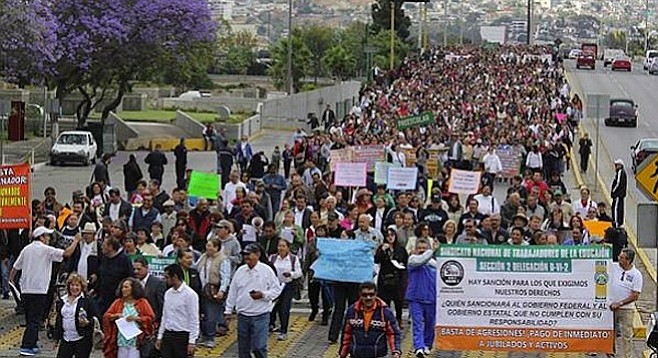 Facebook
Facebook
 X
X
 Instagram
Instagram
 TikTok
TikTok
 Youtube
Youtube

My eight-year-old godson in Tijuana has been sending me various versions of sad emoticons on Facebook for more than a week now. He is unhappy because, after a lengthy Easter vacation, school did not resume as scheduled.
My godson is one of hundreds of thousands of Baja California school children affected by a teachers' strike that began on Monday, April 13, when teachers began striking in phases. Only some primary schools for certain hours were affected at first.
By Monday, April 20, the strike had spread to all primary schools in the state served by teachers of Section 2 of the National Education Workers Union — more than 1800 elementary schools.
Gradually, the strike has spread to high schools, federal schools, and even to state schools established specifically to train teachers. Press accounts now estimate that more than 600,000 Baja California children will find school doors closed again on Monday, April 27.
At issue is some 653 million pesos (about $43 million) owed to current and retired teachers that has accumulated over the years and has yet to be paid. Both the federal and state governments have conceded that teachers are owed the money, they but are at odds over which jurisdiction owes how much.
State education secretary Mario Herrera Zárate told a civic group in Tijuana last week that Baja California was seeking a 900-million-peso loan (about $59.5 million) from private sources to cover what he described as “debts” owed to the teachers.
According to union leader Rogelio Alejandro Gudiño, some 30 retired teachers have died while awaiting payment of their pensions.
Teachers have taken to demonstrating in the streets of Baja California's major cities, including recent marches in Tijuana's Zona Rio and Baja's state capital, Mexicali. The Mexicali march, on Friday, April 24, drew an estimated 7000 teachers to the street, according to press accounts.
Federal and state authorities have been meeting with union officials in an attempt to resolve the strike amid growing public pressure for a solution. Union leaders said on Friday that some progress had been made, but advances were developing slowly.
In the meantime, teachers have vowed to stay out of the classroom until they receive all the money they are owed. The teachers' union has indicated they will not accept their back payments in dribs and drabs — that the only solution after years of waiting is that the payments be made in one fell swoop.
Some parents who can afford it have placed their children in private schools, while others have taken up home-schooling during the strike, according to the daily newspaper El Sol de Tijuana.


My eight-year-old godson in Tijuana has been sending me various versions of sad emoticons on Facebook for more than a week now. He is unhappy because, after a lengthy Easter vacation, school did not resume as scheduled.
My godson is one of hundreds of thousands of Baja California school children affected by a teachers' strike that began on Monday, April 13, when teachers began striking in phases. Only some primary schools for certain hours were affected at first.
By Monday, April 20, the strike had spread to all primary schools in the state served by teachers of Section 2 of the National Education Workers Union — more than 1800 elementary schools.
Gradually, the strike has spread to high schools, federal schools, and even to state schools established specifically to train teachers. Press accounts now estimate that more than 600,000 Baja California children will find school doors closed again on Monday, April 27.
At issue is some 653 million pesos (about $43 million) owed to current and retired teachers that has accumulated over the years and has yet to be paid. Both the federal and state governments have conceded that teachers are owed the money, they but are at odds over which jurisdiction owes how much.
State education secretary Mario Herrera Zárate told a civic group in Tijuana last week that Baja California was seeking a 900-million-peso loan (about $59.5 million) from private sources to cover what he described as “debts” owed to the teachers.
According to union leader Rogelio Alejandro Gudiño, some 30 retired teachers have died while awaiting payment of their pensions.
Teachers have taken to demonstrating in the streets of Baja California's major cities, including recent marches in Tijuana's Zona Rio and Baja's state capital, Mexicali. The Mexicali march, on Friday, April 24, drew an estimated 7000 teachers to the street, according to press accounts.
Federal and state authorities have been meeting with union officials in an attempt to resolve the strike amid growing public pressure for a solution. Union leaders said on Friday that some progress had been made, but advances were developing slowly.
In the meantime, teachers have vowed to stay out of the classroom until they receive all the money they are owed. The teachers' union has indicated they will not accept their back payments in dribs and drabs — that the only solution after years of waiting is that the payments be made in one fell swoop.
Some parents who can afford it have placed their children in private schools, while others have taken up home-schooling during the strike, according to the daily newspaper El Sol de Tijuana.
Comments